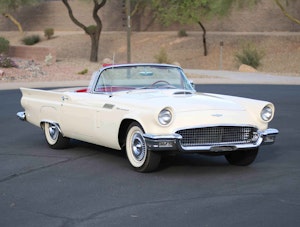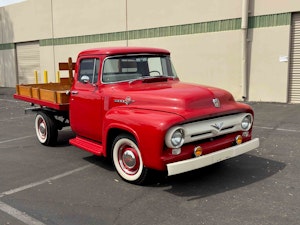Media | Articles
2020 Tacoma TRD Pro tackles trails with the best of them
As soon as the Army Green 2020 Tacoma TRD Pro landed in my driveway I climbed into the cab, eager to poke and prod at all the interior gizmos and see what had changed since the last time I’d been in a Tacoma, which was right after its 2016 refresh. Immediately I banged my head into the roof, which was lowered because of the power-sliding sunroof. My knees dragged under the steering wheel, already tilted to its highest position, as I tried to get comfortable. The Tacoma’s high floorboards gave the feeling that my feet were way in front of me, and the driving position was just different enough to register as foreign. After eagerly awaiting its arrival, I suddenly had a feeling I wasn’t going to like this truck. I didn’t—at least for the first hour or so.
Like all Tacomas, the TRD Pro has high floorboards, giving the initial impression that you’re driving on top of the vehicle rather than inside it. I still wish the steering wheel could tilt up even more, as drivers with long legs will have to maneuver under the steering wheel when entering or exiting the cab. However, after spending a few hours behind the wheel, all of my other gripes about the seating position and ergonomics faded; the benefits of the TRD Pro package did not.
Toyota’s TRD Pro package builds upon the already stellar off-road reputation of the Tacoma with a slightly taller TRD-tuned suspension consisting of Fox 2.5 internal-bypass shocks, a front skid plate, a TRD exhaust, and Rigid Industries LED fog lights. The TRD Pro’s 16-inch wheels are shod in 265/60R16 tires (a metric-sized stand-in for 31×10.5R16s) that are virtually the same height as those one other Tacoma 4x4s. Inside there are sturdy rubber TRD floor mats and a TRD Pro shift knob. This example also carried the optional Desert Air Intake ($725) TRD Pro graphics package ($699), and various emblems, mats, tie down, and bric-a-brac ($624) to bring the TRD Pro’s $47,785 base price to an MSRP of $49,833.
Let’s tackle that price first. When I reviewed the equally expensive Chevrolet Colorado ZR2 Bison, readers were shocked at the price, as if they hadn’t noticed that full-size trucks had crossed the $50,000 threshold a decade ago and that an F-150 Limited can crest $70,000. For its price, the Tacoma includes capability that’s hard to find in a full-size. However, the biggest problem this latest crop of off-road mid-size trucks run into isn’t the price; it’s their size. Even with a short bed—the only available option in the TRD Pro—a Double Cab Tacoma has a wheelbase of 127.4 inches and an overall length of 212.3 inches. There are plenty of tight roads and trails where anything larger would just be a liability.
Marketplace
Buy and sell classics with confidence

OK, back to the fun part: driving the TRD Pro off-road. I found some single-track dirt roads north of Ojai, California, on which to test the Tacoma at moderate speeds, and rockier terrain near Palmdale, California, to try out the various electronic aids.
Without turning any of the traction controls or electronic watchdogs off, the stability control seemed a bit intrusive, allowing just a bit of yaw from sliding the back of the pickup around before it intervened. However, just when I was cursing for a bit more leeway while sliding around in the sand at about 15 mph, traction control kicked in. The system kept us on course and neatly avoided plowing the front corner of the skid plate into a sandbank. Lesson learned. What about other terrains, then?
The Tacoma’s Multi-Terrain Select uses a knob to shift between configurations for rock, loose rock, mud and sand, rock and dirt, and moguls. The system changes the throttle response and how much wheel-slip is allowed before traction control kicks in. Strangely, it’s only available then the transfer case is shifted into low range. Who navigates moguls in low range?
Though the TRD Pro did a great job on loose dirt roads in two-wheel-drive and four-wheel-drive high range, I found myself wishing for some of the navigation aids only offered in low range. For example, when shifted into four-wheel-drive low-range, the front, rear, and side-mirror-mounted wide-angle cameras make up what Toyota calls a “Multi-Terrain Monitor” to help spot obstacles as you approach them. It’s handy for placing your tires when navigating rocky terrain, but it could have been equally useful on narrow trails. While those are easily navigated in two-wheel-drive, they often require tight turns to keep the encroaching brush from pinstriping the paint.



I never encountered any true rock crawling, but I did try out Crawl Control (a sort of cruise control for the trail) during some slow going over a dry riverbed, where I picked my way around the largest boulders and clambered over bowling-ball-sized cobble. Available only in low range, and accessed by a button tucked away in the overhead console, Crawl Control pulses the brakes to maintain one of five preset speeds.The sound of the brakes pulsing, like a low-frequency antilock braking, resembled a 12-year-old at their first bass guitar lesson trying to emulate Les Claypool. It’s disconcerting. Best leave it for actual climbing and crawling as it was intended.
Compared to its most direct competitor, the Colorado ZR2 Bison, the TRD Pro is a bit less powerful, has a slightly more jarring ride, and lacks a locking front differential. It doesn’t have the Chevy’s robust underbody skid plates, but it does manage to tuck all vital bits up under the frame rails, giving it a better breakover angle. While the Colorado may be able to scramble over rocky terrain with all four wheels churning, the Tacoma’s greater ground clearance and approach angle may help it navigate similar terrain with less scraping and banging on the underbelly. The ZR2 Bison seems to have an edge in the high-speed desert running department, thanks to its fantastic Multimatic DSSV shocks, so it’s a bit more biased towards sailing over whoops; the Tacoma is nicely balanced to crawl and haul.
Back on pavement, the highway ride is firm but the steering isn’t overboosted. The only real disadvantage of the taller suspension and tires, as long as you don’t try autocrossing the TRD Pro, is some noticeable brake dive. The all-terrain tires weren’t obnoxious on the highway, and lacked the typical howling of similar, aggressive tread patterns. Although I did catch myself turning up the stereo, it was only to alleviate road and wind noise, which produced well-tuned white noise, rather than anything offensive or annoying.

The exhaust note, which seemed more strained than you’d expect when maintaining freeway speeds up a grade, could use a more sporty sound than the TRD’s cat-back exhaust provides, but that’s the most minor of gripes. The 3.5-liter V-6 would benefit from some additional power to make up for the extra drag of pushing the taller TRD Pro through the air or, perhaps, a couple more gears in its transmission to aid acceleration. Although it uses the same 3.91:1 rear axle ratio as any other automatic-equipped Tacoma, the 4.30:1 ratio of the manual transmission Tacomas would only raise engine speed by about 200 rpm at highway speed in sixth gear and allow for it to stay in its top gear a bit longer. Of course, that lower ratio would come at the expense of fuel economy, which, like our ZR2 Bison, was in the 17–18 mpg range.
Not at all jaded by my initial impression of the Tacoma and its unique ergonomics, I was sad to see the TRD Pro leave. For off-road enthusiasts and weekend warriors, the Tacoma TRD Pro is among the best mid-size offerings on the market today, and thus worthy of your consideration.


















